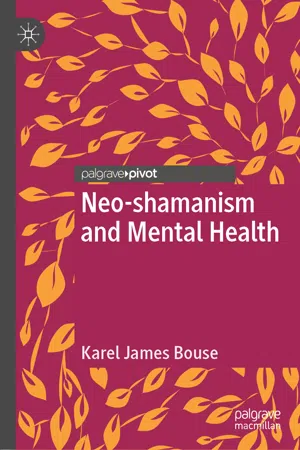You have no need to travel anywhere – journey within yourself.Enter a mine of rubies and bathe in the splendor of your own light. —Rumi

- English
- ePUB (mobile friendly)
- Available on iOS & Android
Neo-shamanism and Mental Health
About this book
This book explores the contemporary practice of Neo-shamanism and its relationship to mental health. Chapters cover the practice of Neo-shamanism, how it differs from traditional shamanism, the technology of the shamanic journey, the lifeworlds of some of its practitioners, as well as its benefits and pitfalls. The author's analysis draws on an in-depth study of existing literature, original qualitative-phenomenological research into the lifeworlds of practitioners, and nearly three decades of observation and experience as a student, teacher and practitioner of Neo-shamanism. She discusses the potential role of Neo-shamanic journey technology as an approach for psychology-based studies of consciousness and anomalous phenomena; its value as a tool for self-exploration as part of a supervised curriculum; as well as the possible therapeutic applications of the journey and shamanic healing protocols for use by mental health professionals.
This bookis a rich and timely resource for students and teachers of psychology, anthropology and sociology, psychotherapists, and anyone who is interested in consciousness and parapsychology.
Frequently asked questions
- Essential is ideal for learners and professionals who enjoy exploring a wide range of subjects. Access the Essential Library with 800,000+ trusted titles and best-sellers across business, personal growth, and the humanities. Includes unlimited reading time and Standard Read Aloud voice.
- Complete: Perfect for advanced learners and researchers needing full, unrestricted access. Unlock 1.4M+ books across hundreds of subjects, including academic and specialized titles. The Complete Plan also includes advanced features like Premium Read Aloud and Research Assistant.
Please note we cannot support devices running on iOS 13 and Android 7 or earlier. Learn more about using the app.
Information
1. Contemporary Application of an Ancient Technique
Abstract
Keywords
Neo-shamanismShamanismShamanic journeyCultural dissonanceTable of contents
- Cover
- Front Matter
- 1. Contemporary Application of an Ancient Technique
- 2. Method of Research
- 3. Neo-shamanism as an Alternative Contemporary Worldview
- 4. Neo-shamanism as a Tool for Self-Exploration
- 5. Potential Pitfalls of Neo-shamanic Practice
- 6. The Journey Technique as a Method for Consciousness Studies
- 7. Conclusions
- Back Matter